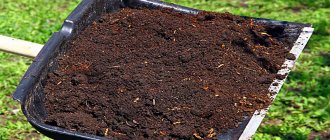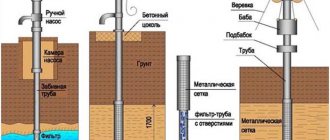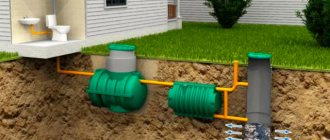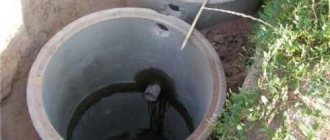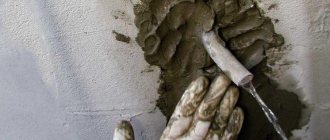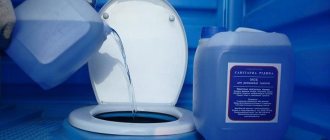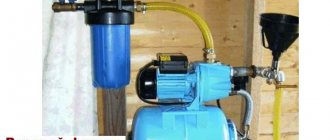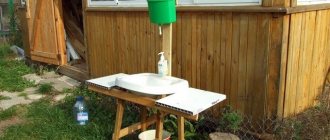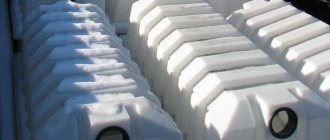In summer cottages with fruit trees, shrubs, vegetable gardens and berries, remote from large populated areas, the problem of recycling not only household waste, but also rotten fruit and vegetable products is always relevant. In this situation, the solution to the problem of getting rid of organic residues is often a self-made compost bin, the manufacturing options of which are distinguished by their design simplicity and availability of materials.
Before building a composter, they usually look through numerous photographic materials on the Internet, selecting the desired design option with available budget components. With proper installation in compliance with the following technologies for assembling and using the container, waste composting will occur with high efficiency, and the garden composter will last for quite a long time.
Rice. 1 Composters on the site with the finished product
Which is better, a compost bin or a bin?
Unlike manure, compost does not “burn” and does not burn plant roots. At the same time, it has no less, and in some cases even greater, nutritional properties.
The contents of the compost pit rot more slowly
Initially, compost was placed in pits, covered with a layer of soil . But, firstly, such a structure is only possible if there is a large plot. Secondly, compost matures in such pits without air access much more slowly than in ventilated containers. This process is lengthy and takes on average at least 3-4 years. This method is called anaerobic.
In boxes, that is, ventilated containers in the presence of oxygen (aerobic method), plant residues rot in 1-2 years, that is, much faster. Plus, compost can be added periodically, which cannot be done with the anaerobic ripening method.
Therefore, even in large areas, it is better to use special containers rather than pits to produce this valuable fertilizer. This technology is called Finnish.
To speed up the ripening process, plant residues must be enriched with oxygen. To do this, turn the contents of the box with a pitchfork more often (at least once a month). Moreover, this must be done from the sides to the center, without disturbing the edges.
Important nuances of composting
The compost is laid horizontally in even layers. Periodically these layers are mixed with manure. Lay without compacting, so as not to block the access of air and not to interfere with the work of bacteria responsible for the formation of fertilizer.
Do not allow this mass to dry out; water it periodically with water, especially during the dry period. And it is impossible to over-moisten what is contained in the box, because in this case the necessary bacteria may die.
It is necessary to water the resulting compote with EM (effective microorganisms) preparations more than once a season. Do not pour the entire bottle into the box. Such a bottle (0.5 liters) must be divided into five buckets of water, and 100 grams of candied jam should be added to each of them. This sweet supplement will come in handy for the bacteria to start working.
Let these buckets sit for a while, then this liquid should be poured evenly onto the compost. The effect of this technique has been proven - the fertilizer ripens much faster.
Sanitary standards and accommodation rules
To avoid fines and conflicts with neighbors, be sure to consider the location of the compost bin. According to SNiP 30-02-97, the close location of composting devices near residential buildings is unacceptable. The minimum distance from them is 12 m.
You will need to retreat 8 m from reservoirs, drinking wells and wells. Such structures should not be placed right next to a neighbor’s fence - you should retreat 1 m from them.
Five easy steps to make compost
In practice, they try to remove them to the most remote part of the site. To prevent the smell from spreading throughout the area, the location must be protected from winds. You should not install boxes in low areas, otherwise melt water will wash away the contents.
The ideal place is on a small hillock.
Organic waste compost should not be placed in direct sunlight - it will burn if there is too much heat in direct sunlight. Excess moisture is also dangerous for it.
Therefore, it is better to install such a container in partial shade under cover, in the shade of trees.
Briefly about the main thing
There is nothing complicated about how to make compost at your dacha with your own hands. To do this, various organic waste collected on the site and in the house is stored in a heap. To prevent the appearance of decomposing organic matter from disturbing the eye, boxes are built for it from boards, construction pallets and other similar materials, mesh baskets are made, or any containers of suitable volume are installed. There are also ready-made plastic composters on sale. The ripening time and quality of compost depend on compliance with the laying rules.
Ratings 0
Materials for production
There is no need to use expensive materials to make a compost bin. Old boards will do just fine. It’s great if there are still pallets left after transportation. They are made from a solid board, and a box made from it will last a long time.
Slate is a less successful material for manufacturing. The contents in it will rot too slowly.
The simplest container for compost
To make the structure last longer, it is better to treat the wood with an antiseptic. To protect from rain and snow, you can cover the compost box with regular plastic wrap (it’s better to take black) or slate. But it is better to make a thick wooden lid so that the smell does not leak out. And without access to light, the compost will rot faster.
Some gardeners use other available materials to assemble the box. For example, a metal mesh fence stretched over posts.
Don’t get too carried away with store-bought dietary supplements that speed up compost maturation. After all, their excess can lead to acidification of the soil. If there is a need to use them, dilute the resulting humus with sand or ground clay in a ratio of 1:2 or 1:3.
Dimensions
We'll tell you in detail how to make a compost box. There is no need to build a container that is too large, otherwise the contents will quickly burn out due to excess heat. If the volume of the box is small, the plant residues will begin to dry out, and such compost will be of little use.
Setting up a compost bin
A container with three compartments is very convenient to use. In one, plants can be planted on partially rotted plant debris, in the second, compost will be prepared, and in the third, humus will be stored.
- The size of each compartment is 1.5x0.7x1.5 or 1x0.5x1 m (width, height, length)
- Thus, the total length of 3 boxes will be 3-4.5 m.
For a small area, you can make a container with one compartment. Raw materials are loaded into it from above, and the finished fertilizer is selected through a door located in the lower third of the box.
Design
No special drawings are required to make a compost bin.
Box consisting of 3 sections
Its design is simple:
1First, each of the 4 walls is assembled from boards and cross bars.
2The compost bin must be ventilated, so be sure to leave a small distance of 1 cm between the boards.
3The lower part of the front wall must be hinged so that it can be easily opened and the contents dumped out.
4To divide the box into 3 separate sections, make 2 partitions.
5 It is better to make the lid gable. The second slope is attached to regular window hinges, while the first one remains stationary. In this case, when the lid is folded back, it will rest on the adjacent slope and will not sag.
6The last stage is assembly. Since the compost ripens faster at the bottom, it makes sense to equip the bottom of the box with an opening door through which the fertilizer will be collected. That is, you will put plant residues through the top, and take the rotted humus from below.
7 First, 3 walls are screwed to 4 side posts with self-tapping screws and galvanized brackets, 2 partitions are installed in the center, then the lower part of the front wall is hinged and the upper part is screwed. To protect the wood from cracking, pre-drill holes for them before screwing in the fasteners.
8To fasten the doors, it is better to use cap hooks with earrings.
9The bottom of the box is assembled from slabs. It is also necessary to leave several slots in it to drain excess water.
10To enhance ventilation, it is better to install the structure not on bare ground, but on wooden supports. They are screwed or nailed to the bottom.
11To protect against rodents, it is better to line the bottom with a metal mesh with fairly small cells. It can also be secured to the sides of the structure using a furniture stapler.
A compost bin made from pallets is even easier to assemble. You just need to connect several pallets together, attach them to the side posts, attach the bottom and hang the lid.
It will be more convenient if you assemble all the walls of the box using cap hooks. In this case, if necessary, it can be easily disassembled completely and moved from place to place.
Video description
Watch a video about the construction of a wooden composter:
Mesh composter
A suitable material for making a composter is a durable galvanized steel mesh with cells of any size. In addition to this, you only need wire and air-permeable non-woven material - spunbond or lutrasil.
- A cylinder is rolled out of the mesh, making an overlap of 15-20 cm, and fastened with soft wire.
- The resulting basket without a bottom is placed in place, having first removed the turf from the ground, and tied to a fence, pole, or any other support.
- The inner walls are covered with spunbond.
If appearance is not important, you can do without non-woven material Source myhappyhomestead.com
How to decorate a container?
A compost bin made from rough-hewn boards does not look very aesthetically pleasing. Therefore, if desired, it can be painted in any color or covered with drying oil or stain. Have your kids decorate it with pictures using a spray can. A bright container will only decorate the area.
You can assemble an unusual decorative structure and close the box with it from thin wooden slats assembled crosswise in the form of a lattice. Plant climbing plants on the sides. Such a structure will be an excellent decoration for the site.
Capital construction options
To build the box you will need new thick boards. Compost is created with the help of bacteria that process waste; this is an aggressive environment for any organic substances (the boards with which the box is built can decompose). That is why you need to choose reliable boards, treat them with a special compound to prevent rotting, and you can paint them well.
Between the boards you need to leave gaps, the width of which should be several centimeters. This is necessary so that the compost can receive a sufficient amount of air, this is a prerequisite!
Compost bin option. The illustration for the article is used under the standard license ofazende.ru
What can you put in compost?
What you can and cannot put in compost
It is allowed to put any quickly rotting plant waste into compost.
The most important thing is that they are environmentally friendly:
- plant tops left after harvesting
- dry leaves
- weeds pulled out during the season ; often gardeners are afraid of plants with ripened seeds getting into compost bins, although, in principle, the seeds can quite safely rot together with the rest of the organic matter; you just need to put the weeds with them in the very center of the compost and be sure to cover them on top with other plant debris
- sawdust, wood ash or cardboard : their addition to biomass speeds up the ripening process; but, since during the decomposition process they are able to “lock in” nitrogen, there should not be too many of them in the compost; It is only unacceptable to use sawdust obtained during the processing of wood painted or impregnated with chemicals
- food waste , except meat and dairy products: potato peels, cores and peels of vegetables and fruits, seed husks, drunk tea, coffee grounds, etc.
- eggshells , rich in calcium
- peat
- chicken droppings and herbivorous animal manure : a compost container can be used to quickly rot the manure - after all, when fresh, it can burn the roots of plants
Basic rules for bookmarking
To speed up the fermentation process, do not dump all organic waste randomly. Otherwise, they may become blocked and become covered with fungus. Wet and dry layers (for example, straw) must be alternated. To speed up ripening, large plants are crushed to a size of 20 cm.
An ideal compost should contain a layer of about 20 cm of plant residues, 5 cm of manure and 15 cm of kitchen waste . That is, plant residues should be about 70%. To speed up the process, some gardeners alternate them with 5-7 cm layers of soil.
Plant waste can be used as an excellent fertilizer
Both excess moisture and lack of it are very dangerous for compost. It should feel like a wrung out sponge. Optimum humidity 45-70%. Dry biomass decomposes very poorly; too wet biomass becomes too dense, and the components stop interacting with each other.
Excessive overheating is also dangerous - favorable development of microorganisms occurs only at temperatures up to +60 C, after which they die. Therefore, you should not make compost bins that are too large.
If the compost bin does not have a bottom, prepare drainage from tree branches before laying the main mass. It is advisable to shed the pile with infusion of manure. Hay or straw is poured on top. In the winter, to protect from the cold and prevent the leaching of nutritional components, the compost is covered with film or an old carpet.
The principle of operation of the country option
In order to obtain organic fertilizer the following can be used:
- Fallen leaves
- Cut grass
- Food waste
- Feces
But for the process to proceed correctly, a container such as a composter is needed. It should have holes to remove excess moisture and allow air to enter the collected mass.
Watch the video, expert advice, principle of operation:
Moreover, the waste must be placed in layers, each of which must be sprinkled with peat, sawdust or ordinary soil from the site. This is necessary for the development of microorganisms leading to the decomposition of residues and their transformation into compost.
What should not be in compost?
Poorly biodegradable components and hazardous chemicals or organic compounds should never be added to a compost bin or bin.
What doesn't belong in compost
So, it shouldn't contain:
- feces of domestic animals , as they may contain eggs of dangerous parasites; for example, cats are carriers of toxoplasma, cysts of which can settle in the tissues of the human body
- dairy and meat products : firstly, they decompose much more slowly in compost, and secondly, with the help of them you will attract rats, mice and wandering animals to the place where they are stored
- boiled kitchen waste , even vegetable waste, is also undesirable - it will attract flies, plus emit an unpleasant odor when decomposed
- contents of the vacuum cleaner : it has been proven that household dust contains tiny particles of synthetic fabrics that cannot decompose in the soil, and harmful chemicals formed during the operation of furniture and equipment
- plasterboard : despite the fact that its main component is ordinary cardboard, which can rot quite quickly, due to the introduction of chemicals into its composition, it is better not to use this material as compost
- large pieces of wood : they will overheat for too long
- newspapers and magazines : printing ink is a rather toxic substance containing salts of heavy metals
- coal ash and slag , which are almost impossible to rot
- roots of some perennial plants , for example, sow thistle, horsetail, bindweed; they are so tenacious that they will immediately begin to germinate right in the compost pit
- pig manure and human feces due to the high likelihood of containing helminth eggs
Nightshade tops and potato peels can be added in small quantities. After all, they contain a rather toxic poison called corned beef.
How long does it take to prepare?
With aerobic maturation without the use of special preparations, it can take from 1 to 2 years before the plant residues completely rot and humus is formed from them. The resulting mass differs from ordinary soil in color.
It is a dark or light brown wet substance that, when squeezed by hand, sticks together into a lump and does not stick to the palm. It should have a pleasant earthy smell. Upon closer inspection, small undecayed inclusions are visible in it.
Humus formed as a result of compost overheating
In warm weather, ripening occurs faster. It also speeds up with frequent stirring of the heap. Much depends on the type of plant residues. For example, it is better to plant autumn foliage separately. After all, it contains tannins, which are difficult to decompose substances.
Such compost matures much more slowly - it may take 2-3 years to obtain humus from it. Any type of feces will take a couple of years. Grass freshly cut with a lawnmower can rot in 3-4 months.
The top layer of compost usually does not completely rot. It can be recycled again or used as mulch to keep out weeds. It turns out from unripe remnants of vegetation and is a good bed for cucumbers, pumpkins or zucchini. Grass piled up will continue to decompose, generating heat.
It is advisable to add slightly dried grass and tops to the compost. Otherwise, the decomposition process will take longer.
What is vermicompost?
Vermicompost (vermicompost) is rotten plant residues processed by a special breed of worms called California worms, which can be bought in the store.
Earthworms are also used to make it. Such compost is close in nutritional value to pure manure and contains more nitrogen, potassium and phosphorus. After all, the resulting substrate - coprolite - is essentially a substance that has passed through the intestines of the worm. It is added in smaller quantities.
Vermicompost
However, it’s hardly worth singing the praises of this product either. Ready-made vermicompost costs a lot and is often used to fertilize indoor plants. The pleasure is too expensive.
The worms themselves are not cheap either. Plus they are quite capricious. To breed “Californians”, only maintaining above-zero temperatures is required. In severe frosts, compost pits will require special shelter.
Better attract more earthworms to your compost. To do this, a box or pit with rotting fertilizer must be watered periodically, especially in the heat. For a standard box 1-1.5 m wide, you will need 2.5-3 buckets of water, no more, so as not to erode the most valuable fertilizer.
In general, such a procedure is required not only for growing worms. Organic matter should melt, not burn, and this is only possible in the presence of moisture. Therefore, in hot weather, do not forget about periodic watering.
Selecting a location
A number of conditions must be met
It is very important to decide on a location. We do not recommend organizing a compost bin too close to a house or other residential premises, at the very entrance to the site or near entrance roads, etc.
However, anything can be seen. The owner will explain this by saying that he does not want any specific place to disappear. In fact, it is recommended to organize the box in a secluded place, for example, in the corner of the plot, in the shade, and not in the sun (the compost does not need to dry very much).
It is also necessary to make it convenient to approach the compost bin, for example, make an ordinary path, because you will have to walk there constantly (with weeds and buckets of unnecessary waste from the kitchen). In front of the box itself, it is advisable to make a platform with bricks so that you can come up with a cart when the time comes to pick up the compost.
Space for a compost bin. The illustration for the article is used under the standard license ofazende.ru
Liquid fertilizer from compost
There is another term in the fertilizer industry called “vermicoffee.” No, this is not a processed coffee bean product. Vermicompost is a common aqueous extract from vermicompost that has a reddish-brown hue. An ordinary advertising ploy, nothing more.
You can prepare a liquid fertilizer of a similar composition (perhaps a little less saturated) for watering plants from ordinary compost. And absolutely free. By the way, this substance also has its own name. It is called vermichay.
Fertilizing strawberries
This nutritious fertilizer is made from blackened plant residues that have begun to rot, which have lain in a box for 2-3 months. To do this, place it in a large container at a height of 1/3, fill it with water and leave it in the sun for 3-4 days.
It's great if you can get an old cast iron bathtub. This capacity is enough to water even a large area. An iron barrel will not last long - after all, in the process of decomposition of bioresidues, the metal will also suffer.
Vermicha can be used to water any type of plant. Since plant residues do not completely rot in a short time and may contain pathogenic organisms that are dangerous to plants, to reduce the risk of plant diseases, it is better to add a little wormwood or nettle to the infusion.
The best cooking recipe
The most useful compost is made from a mixture of peat, manure, soil, fallen leaves and wood ash, to which a little slaked lime is added. As you know, peat is a loose rock made from the remains of moss; it is not used in its pure form due to its high acidity.
But in the process of overheating, it turns out to be a wonderful fertilizer.
Well-rotted compost has a brown tint and sticks together well.
Most types of plants (except, perhaps, pumpkin plants - melons, cucumbers, zucchini, etc.) have a negative attitude towards fresh manure. Before mixing it with the soil, it is better to first put it in compost containers made from boards or a pit.
To make a peat-manure mixture, it is mixed in this way: first, half a meter of peat is laid out, then a small 20-centimeter layer of manure, and again peat 50-60 cm high. Cover the resulting mixture and leave it to rot for a year.
You can put it directly in stacks or boxes. In the spring, the rotted mixture can be added to the soil when digging.
When adding manure to compost, remember that the rate of decomposition depends on the type. The horse overheats faster. Cattle feces decompose more slowly. Moreover, pork and sheep not only take longer to process, but also increase the acidity of the soil.
Types of composters
In addition to conventional boxes of various models, modern improved designs are produced - for example, thermocomposters, which allow you to get results in an accelerated mode by constantly maintaining a very high temperature. These are closed barrels or hemispheres, often sealed, quite compact and look good in the landscape (attention is paid to design).
There are vermicomposters where the main “employees” in processing the material are worms, which are placed specifically in the appropriate tank. The composter with worms is practically airtight, it can be installed not only outdoors, but also in a building, which helps to obtain mature compost all year round.
Is it possible to dig up immature compost?
It is not at all necessary to wait until the plant residues have completely rotted and turned into brownish crumbly humus. It is enough for the mixture to decompose at least half. Moreover, adding unripe compost is more beneficial for gardeners.
Compost is spread over the area before digging
There are several reasons for this:
- semi-decomposed plant fibers make the soil looser and allow plants to create convenient passages for roots
- such a fertilizer is “long-lasting”, that is, it, while continuing to rot in the ground, supplies the sprouts with nutrients gradually, over one or two seasons
- unripe compost is food for soil fungi and earthworms, which will loosen the soil
If the fibers are too coarse, they must be crushed with a shovel. Although it is better to chop large plant stems before adding compost.
Ready-made humus, which looks like ordinary brown soil, is used more often as an emergency measure on severely depleted lands or when planting depleted plants to better strengthen them.
In the latter case, it is brought directly into the hole and mixed with soil. Moreover, it is undesirable to store humus - over time, some of the nutrients and nitrogen in it are lost.
Cyclic use of compartments
You can fill one compartment first, leave the other compartment free. Next spring, when last year’s fertilizer has melted, transfer the top, which has not had time to ripen since the fall, into the second compartment, to the bottom. And during the summer period, put the compost materials there.
But you can use the black substrate, which is already ready (about one-half of the first compartment), on the site, so you will gradually free the compartment completely. If during the spring period you do not have time to use all the fertilizer from the first compartment and spread it around the site, do not be lazy to keep the supplies in bags; you will need them in the fall.
Such situations are extremely rare. There is always a use for fertilizer. Everything will happen again next spring.
The illustration for the article is used under the standard license ofazende.ru
How to compost?
In pristine soil, not depleted in nutrients, the top 5 cm always contains humus - organic compounds important for plants. When it is depleted, it is necessary to recreate a similar chemical composition.
This is done by digging up the ground and adding compost onto the bayonet of a shovel - simply throwing it over the top will not be enough.
Moreover, the more thoroughly the compost is mixed with the soil, the less will be the process of weathering, and the likelihood of losing valuable nitrogen will decrease.
For 1 sq. m is enough 6-8 kg (2/3 bucket) of compost.
Adding finished compost
For each crop, the time of its application may differ. So, under fruit trees it is brought into the tree trunk area closer to mid-September. This must be done using half a shovel. In this case, part of the compost will already be absorbed by the plant in the fall, and it will be better prepared for winter.
In early spring, when digging is still difficult, the fruit crop will receive a new portion of nutrients, so necessary for the formation of ovaries. Ornamental perennials are fertilized in a ring or between rows.
Bulbs or plant seedlings that have not yet sprouted roots should not be placed immediately into unripe compost. After all, half-rotten organic matter is still quite “aggressive”. Continuing the “work”, it can damage the delicate roots. Therefore, seedlings and bulbous plants are isolated from contact with compost using a 5-10 cm layer of ordinary soil.
Garlic and other bulbous plants planted before winter are fertilized as follows . The compost is placed between the rows so that its effect occurs in the spring. Under ordinary beds, this fertilizer is dug up a couple of weeks before sowing or in the fall, in October. If the ground has already been dug up, you can simply work the compost into it using a hoe.
Ornamental plants also like compost. They can be used to mulch, for example, roses. It will not only gradually supply them with nutrients, but also inhibit the growth of weeds. Plus it will retain moisture. This is done only in spring or summer. Before winter, it is better to remove the compost so that the roots of the flowers do not rot.
Freshly made compost is always oversaturated with nitrates, so after adding it to the soil in the first year, plant pumpkin crops or peppers in this place. Unlike fresh greens, these plants are not able to accumulate harmful substances in the fruits.
Cabbage and celery respond excellently to compost. But you should not plant cucumbers on fresh humus - they are not afraid of manure, but on compost they will suffer greatly from powdery mildew. Next year, any crops can be grown on the plot.
